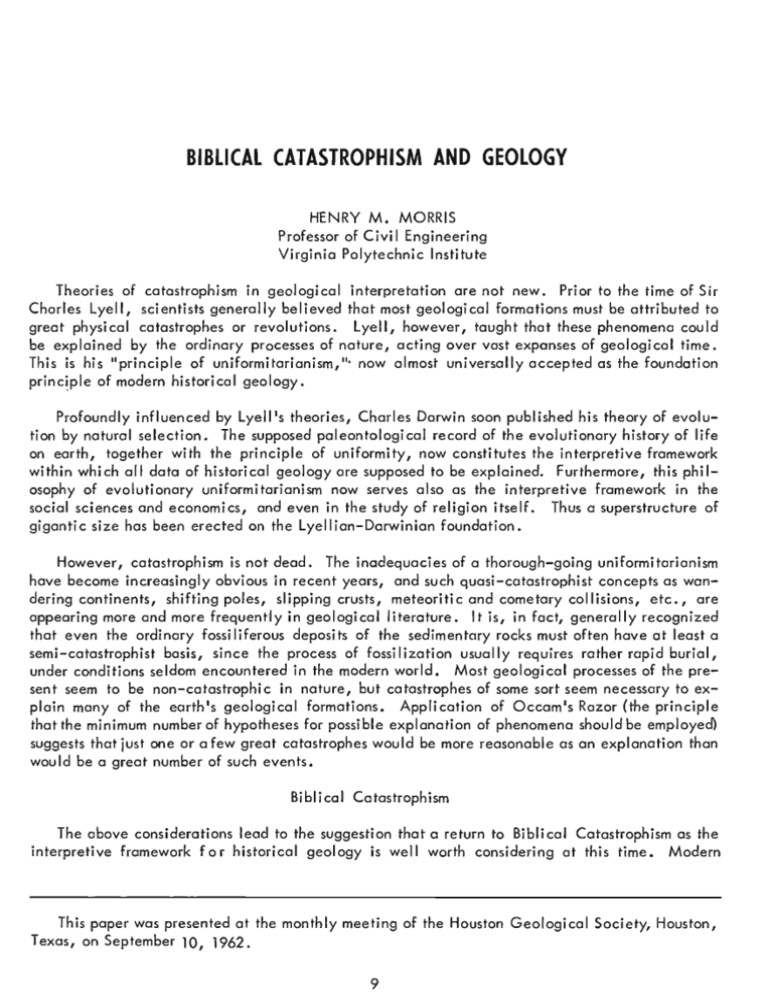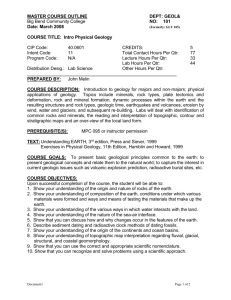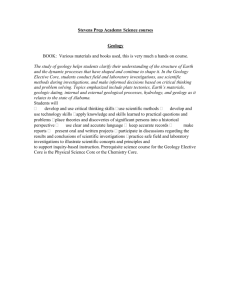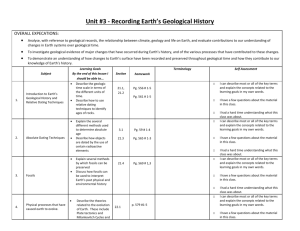biblical catastrophism and geology
advertisement

BIBLICAL CATASTROPHISM AND GEOLOGY HENRY M. MORRIS Professor of Civi I Engineering Virginia Polytechnic Institute Theories of catastrophism in geological interpretation are not new. Prior to the time of Sir Charles Lyell, scientists generally believed that most geological formations must be attributed to great physical catastrophes or revolutions. Lyell, however, taught that these phenomena could be explained by the ordinary processes of nature, acting over vast expanses of geological time. This is his "principle of uniformitarianism, II. now almost universally accepted as the foundation princ~ple of modern historical geology. Profoundly influenced by LyelPs theories, Charles Darwin soon published his theory of evolution by natural selection. The supposed paleontologi cal record of the evolutionary history of life on earth, together with the principle of uniformity, now constitutes the interpretive framework within which all data of historical geology are supposed to be explained. Furthermore, this philosophy of evolutionary uniformitarianism now serves also as the interpretive framework in the social sciences and economi cs, and even in the study of religion itself. Thus a superstructure of gigantic size has been erected on the Lyellian-Darwinian foundation. However, catastrophism is not dead. The inadequacies of a thorough-going uniformitarianism have become increasingly obvious in recent years, and such quasi-catastrophist concepts as wandering continents, shifting poles, slipping crusts, meteoritic and cometary collisions, etc., are appearing more and more frequently in geological literature. It is, in fact, generally recognized that even the ordinary fossiliferous deposits of the sedimentary rocks must often have at least a semi-catastrophist basis, since the process of fossilization usually requires rather rapid burial, under conditions seldom encountered in the modern world. Most geological processes of the present seem to be non-catastrophi c in nature, but catastrophes of some sort seem necessary to explain many of the earth1s geological formations. Application of Occam1s Razor (the principle that the minimum number of hypotheses for possible explanation of phenomena should be employed) suggests that just one or a few great catastrophes would be more reasonable as an explanation than would be a great number of such events. Biblical Catastrophism The above considerations lead to the suggestion that a return to Bibli cal Catastrophism as the interpretive framework for historical geology is well worth considering at this time. Modern This paper was presented at the monthly meeting of the Houston Geological Society, Houston, Texas, on September 10, 1962. 9 10 GRACE JOURNAL studies in Biblical archaeology have demonstrated that the Bible is amazingly reliable in its historical sections, despite over a hundred years of propaganda to the contrary. Pious veneration of the Bible for its "spiritual values" is hardly consistent with a rejection of its scientific and histori cal teachings, for if the latter cannot be trusted--that is, statements whi ch are susceptible to actual human investigation and proof--then how can its " sp iritual" teachings, whi ch are not susceptible of proof, be trusted? And the Bible does have a great deal to say about the early history of the earth and the universe, not only in the book of Genesis, but throughout both Old and New Testaments. If the Bible is actually what its writers univocally claim it to be--and what Jesus Christ and His apostles accepted and taught it to be--then it is really and truly the inspired Word of God, and its teachings concerning Creation and other events of early history are not legends but actual facts of history. If one simply assumes this as an act of faith, and makes his deductions on that basis, he soon fi nds that the Bible presents a perfectly consistent and harmonious account of earth history, with which it is possible to harmonize all the data of historical geology, as well as pertinent data in other fields. The objection that such a presupposition will necessarily color the conclusions derived from it is, of course, valid. On the other hand, it should be recognized that evolutionary interpretations also are derived from definite presuppositions. It is nothing but pure assumption that makes a man suppose he must interpret all data within a naturalistic, uniformitarian mold. Therefore, it is not only legitimate but also highly important that the inferences based on the Biblical presuppositions also be seriously considered and evaluated. The Biblical Framework The major elements of the Biblical framework, within which all data should be organized, are three great recorded facts of history. These events are: (1) the Creation; (2) the Fall; and (3) the Flood. The fact of real Creation, out of nothing, is fundamental to any form of theism and especially to Christian theism. For if anything at all has really been II created, II that substance must have been created with an "appearance of age. 1I On the assumption of uniformity, on the other hand, it would always be possible to imagine some sort of evolutionary history for even the simplest created substance. Denial of the possibility of the creation of lIapparent age" amounts to denial of the possibility of any genuine creation and thus is essentially atheism. Another intensely significant fact concerning Creation is that it was accomplished by processes no longer in operation. According to the Bible, all things were created in six days, following which II God ended his work which he had made" (Gen. 2:2)0 The Sabbath was then instituted in commemoration of God's completed work of Creation. Therefore the physical processes which we can now study belong to an entirely different order of things and can give us no clue whatever to the history of the Creation period; this latter history can only be known through divine revelation. This conclusion is strongly confirmed scientifically by the law of energy conservation, the first law of thermodynamics. This is the most firmly established of all scientific laws and is really BIBLICAL CATASTROPHISM AND GEOLOGY 11 the basic principle upon which all modern science is really grounded. Energy, in the fullest sense , includes everything in the physical and biological universe, and this law essentially affirms that no creation of energy is now taking place. Such creation must therefore have been an event of the past, and this is exactly what Scripture teaches. To some extent, therefore, the whole world was created at some time in the past, by processes unknown to us, with an "appearance of age." This fact must be given full consideration in the construction of a geological history or the use of a geological chronometer. For instance, the primeval ocean may already have been saline, radioactive minerals may already have contained daughter elements, light from distant stars may have been visible on the earth at the instant of their creation, and so on, even as Adam was created as a full-grown man. The second basic fact around which historical data must be organized is that of the Curse. According to the revelation given by God, the original Creation was, in every respect, II very good" (Gen. 1:31). There was nothing out of balance, no disharmony, no suffering, no struggle and, above all, no death in the world According to the Apostle Paul, II by man came death" (I Cor. 15:21). When man sinned, God pronounced a Curse, not only on man but also on his whole dominion, the earth and everything in it. This Curse primarily involves the principle of decay and death. The "whole creation" is now in the II bondage of corruption" (that is, II decay"), according to Romans 8:21-22. There is, everywhere, a natural tendency toward disintegration and ultimate death. 0 This Biblical doctrine is, of course, firmly supported by the second law of thermodynamics. This law which, like the first law, is as strongly proved as any fact of science, states that, in any closed system, there is a natural increase of disorder and disorganizati on. The energy (or information, or order) of the system tends to become less available or useful or organized. Everything tends to wear out, to grow old, to run down, and finally to appr.oach a state of death. Obviously this law flatly contradicts the notion of evolution, which assumes that everything naturally tends to become more orderly and highly organized. But the most significant of these facts, from the standpoint of historical geology, is that there could have been no suffering or struggle or death in the world until after man had sinned. Consequently, the fossils of all formerly living animals now found in the earth's sedimentary rocks must be dated subsequently to this event, the Fall of Man. This leads to the third basic fact in the Biblical framework. If the great thickness of fossilbearing strata have been deposited only ~ man1s fall, then nothing less than catastrophic deposition can possibly account for most of them. The Bible clearly describes this Catastrophe, and we now know it as the Genesis Flood or as the Great Deluge in the days of Noah. According to the record, it was because of the utterly and hopelessly wicked condition into which the earth's original peoples had degenerated that God sent a cataclysmic Deluge to II destroy man with the earth" (Gen. 6: 13). This event is described in detai I in Genesis 6 through 9 and is referred to many times in other parts of the Bible and by Jesus Christ Himself. I t is also recorded, in more or less incomplete and distorted fashion, in the legends of hundreds of peoples all over the world. 12 GRACE JOURNAL According to the Apostle Peter, lithe world that then was, being overflowed with water, perished ll (II Peter 3:6). As described in the Bible, the flood-water covered the entire globe for a year and was immensely destructive in effect. All of the processes of sedimentation, volcanism, te c tonism, fossilization, etc., were extremely active during this period. No true scheme of historica l geology could possibly be erected without full consideration of the tremendous geologic records that must necessarily have been inscribed in the earth's crust by this event. Geologic Implications Acceptance of this Biblical framework of interpretation would have very little effect on the organization and use of the vast bulk of accumulated geologic data and methodology. The disciplines of mineralogy, petrology, hydrology, structural geology, petroleum geology, economic geology, etc., would be very little affected, in any practical way, by the problem of whether the data of histori cal geology should be organized in terms of evolutionary uniformitarianism or in terms of Biblical Creationism and Catastrophism. There are essentially only two signifi cant points where changes in interpretation would be nec.essitated, but these are quite important. In the first place, the principle of uniformity must be modified sufficiently to accommodate the three great discontinuities of Creation, the Fall, and the Flood. In the second place, the theory of evolution must be abandoned. Although these two concepts are pure hypotheses, whi ch have never been verified, they of course have the status of Sacred Cows, and one can question their universal validity only at the risk of being charged with medieval ignorance and prejudice. Nevertheless, their validity has never been demonstrated and they are simply accepted asArticles of Faith. In fact, there is an abundance of scientific evidence that they are not valid. Rather than being hindered by their rejection, it is very likely that historical geology would be greatly benefited by release from their shackles. With reference to uniformity, it has already been noted that this principle has proved inadequate in numerous areas, so that a quasi-catastrophism is already quite prominentin geologic interpretation. There are many very important unsolved problems in geology and it is likely that their solution has been delayed by an implicit reliance on uniformity. Typical of these important unsolved problems are: (1) the cause of mountain-building; (2) the origin of geosynclines; (3) the origin of petroleum; (4) the cause of continental glaciation; (5) the mechanics of overthrowing; (6) the cause of peneplains; (7) the cause of world-wide warm climates; (8) the nature of volcanism productive of vast volcanic terrains; (9) the nature of continental uplift processes; (10) the origin of mineral deposits; (11) the nature of metamorphism; (12) the origin of saline deposits; (13) the nature of granitization; (14) the origin of coal measures; and so on and on. Not one of the above phenomena has yet been adequately explained in terms of present processes, and this is true of an innumerable variety of other important geological phenomena as well. Uniformity is therefore entirely undeserving of its sacrosanct position in geological interpretation. On the other hand, all of the above phenomena lend themselves quite readily to interpretation in terms of the Creati on-Catastrophe framework. The concept of evolution is even more vulnerable than that of uniformity. As already seen, it is squarely contradicted by the second law of thermodynamics. In fact, most of the evidences commonly cited for evoluti on are in reality evidences of deteriorationl For example, the very mechanism believed to cause evolution, that of genetic mutation, is actually a mechanism of disorganization. A mutation results when something causes a sudden and random change in the genetic structure of the germ cell. Such changes, except possibly in such rare accidental circum- BIBLICAL CATASTROPHISM AND GEOLOGY 13 stances as to be negligible, result in a decrease of order in the germ cell and therefore in some definite harm to the creature experiencing it. Natural selection then acts to weed out those creatures experiencing mutations, and thus to preserve the previous form of the species. If any permanent change occurs in the natural state, it almost certainly must be a deterioration of the species (witness the evidence of vestigial organs, and the evidence that most modern animals are represented in the fossil record by larger and stronger forms than are now living). The onlyevidence for evolution carrying anyrealweight is that afforded by the fossil record itself, which presumably shows a gradual increase of variety and complexity of organisms with the advance of geologic time. Thus the data of historical geology, especially that of paleontology, is the only real evidence for evolution, and this is why the study of histori cal geology has assumed such great importance. But in view of the fact that all true scientific law, as well as the testimony of Scripture, negates the very possibility of true evolution, it is evident that this evidence from paleontology has somehow been misunderstood. In fact, a very serious case of circular reasoning seems to be present here. The Geologic Column has essentially been built up on the basis of the fossil data, interpreted on the assumption of evolution. Rocks containing simple fossils are called old and those with complex fossils are called young. The idealized, lOO-mile thick, geologic column does not actually exist anywhere in the world, but has been constructed by superposition of formations from many areas, and the principle used in its erection has been that of evolution. Consequently, the one real proof of evolution has been developed on the basis of the assumption of evolution! This is admittedly an oversimplification of the case, but it is nevertheless fundamentally the correct situation. In any local ity, it is true that there usually seems to be an increase in complexity of the contained fossils with increasing elevation, and also that the fossil assemblages tend to occur in more or less distinct zones. The accepted system of subdivision of the geologic column is quite useful as a taxonomic device, whether or not it has any real meaning as an evolutionary series. Even at best, however, there are many omissions and inversions found at specific localities, and these have to be explained away by such extreme devices as epochs of erosion, overthrusts, etc. It is quite possible, on the other hand, ta explain these same data equally well or better in terms of the Deluge. The Biblical descriptions of the Flood indicate a tremendous complex of events occurring during the Flood year--worldwide torrential rains, tremendous erosion, worldwide tectonic and volcanic upheavals, violent windstorms, gigantic waves and tsunamis, etc., as well as great destruction of all forms of life, followed necessarily by extensive burials in great "graveyards" of future fossil deposits. An infinite variety of depositional characteristics could be postulated at various times and places during the Deluge, often violent but also often relatively quiescent. In general, however, the depositional sequences of fossils, in anyone vertical column, would tend to be from simple to complex, with increase in elevation. This order is that of: (1) increasing elevation af habitat--an ecological zonation; (2) increasing resistance to settling, because of more complex boundary geometry and lesser specific gravity; and (3) increasing size and mobility, with consequent increasing ability to postpone inundation and burial by the rising Flood waters. These sequences would of course be statistical, rather than absolute, and would be subject to many exceptions, but they would certainly represent the dominant trends. And all of this is exactly what is found in the strata, even though it has been misinterpreted to teach evolution! 14 GRACE JOURNAL Thus, the rejection of evolution and of absolute uniformity would not only be quite possible but would probablyalso be potentiallyof great value in further geologic research. As one example of how the Biblical framework could solve a perplexing geologic problem, consider the question of worldwide climatic change. The Bible indicates that there existed before the Flood a vast blanket of water vapor around the earth. Among other things, this thermal canopy would have produced just such a universal warm, pleasant climate as is indicated for most of the systems of the geologic column. I ts precipitation not only was one of the two main causes of the Flood (the other was the , worldwide break-up of the "fountains of the great deep, II whi ch were probably vast subterranean waters and magmas previously restrained under great pressure below the crust), but also would have led to a sudden chilling of the climate and resultant continental glaciation. Importance of the Question If all of this were simply a question of geology and its interpretation, there would be little reason for anyone to press for such a radi cal shift in orientation as here proposed. Even if this were all, however, the possibility of an alternative type of scientific generalization would at least warrant investigation, strictly from the scientific standpoint. However, there is much more at stake here than simply a matter of geologic interpretation. The philosophy of evolutionary uniformitarianism has penetrated very deeply into nearly every aspect of human life. Evolution has become fundamental in the treatment of psychology, of sociology, political science, economics, philosophy,--even religion. It is the cornerstone of Dewey's educational philosophy. Through Nietzsche's adoption and application of Darwinism, evolution became eventually the quasi-scientific basis of Fascism and Nazism. Even more seriously, Karl Marx adapted and extended the concept of evolution in developing the Communistic system, and modern Communism today is grounded squarely on the theory of evolution. This is true, in fact, for socialism and all its forms, as well as for every other anti-Christian system of the present day. Jesus said: "A good tree cannot bring forth evil fruit" (Matthew 7: 18). The modern fruit of the evolutionary philosphy--Communism, Nazism, progressive educationism, materialism, existentialism, Freudianism, behaviourism, and the rest--warrants a very serious and critical look at the nature of the tree itself. Modern geologists can render a uniquely important service to mankind by re-examining, critica lly, the paleontological foundation on which rests this gigantic structure of evolution and its bitter fruits . A renewed recognition of the reality of Creation and the sovereignty of the Creator, in the history of the earth and in the lives of men, could serve a mighty evangelistic and purifying purpose in the world,. in these latter days.







